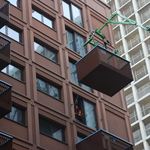That's because they don't usually label them under the headline brand. There's British Airways all business service from London City:
Fly Club World with British Airways, the longhaul business-class service with premium levels of comfort and service to make every journey unforgettable.
www.britishairways.com
BA even had the
Open Skies airline which operated as all business at one point. There's
La Compagnie in Paris today. And there's small carriers that basically run all J services, both as independent corporate shuttles and on behalf of the majors.
Privatair is an example of such a carrier. Far more common is companies running their own bizjets on regular shuttle service. In short, if there's demand, somebody will fill it.
Those don't seem to have conventional business class but ultra high end first class for those who don't to be on the same plane as the rest of the herd. The
Club World London City and
La Compagnie services seem to be a replacement for the Concord. We are getting pretty far from the topic of VIA though.
To be clear, I'm not suggesting that VIA would or needs to do this.
Yet you said:
Not that they would. But if demand warranted it, they absolutely should. That's how economics works. Acela in the US is an example of this. All business class service.
So you think they won't and don't need to but they should?

But I would hope that if they saw the demand, they wouldn't shy away from it.
I am all in favour of matching resources to demand. I just don't see how VIA will have departures any time soon that would
either have high demand for business class but so little demand for economy class that there is no point to add even 1 economy class coach,
or have so much demand for business class that they can't add any economy coaches to the train because they have reached the maximum train length with just business coaches.
I can certainly see how a subfleet of 2-3 all business class trains can be used to boost business class offerings at peak, if necessary. Could even let them reduce business class seating on their other trains.
The thing is, if that subfleet can only be used during peak, they are sitting around doing nothing during other times of the day. Better to have a flexible fleet that can be used all day long, and use pricing (in both classes) to fill empty seats. I have seen trains where the cheapest business class seat is only marginally more expensive than the cheapest economy seat.
The other issue is track capacity. VIA is limited as to the number of trains they can run, so filling a timeslot with a train that only has business class means significantly longer waits for those who either can't buy business class tickets (corporate policy) or are price motivated. HFR will help significantly, but even then, with single track they will still limited to having trains operate in a pre-set frequency designed into the system, based on where the passing tracks are located.
The thing I don't understand is, what do you have against having any economy class coaches on the train you are travelling on?
Based on what? You'd have to have the kind of access that
@Urban Sky has to VIA's yield management model to know whether they have too much business class seating. I trust VIA has the data and modeling to back up their fleet sizing decisions.
I will try and say it a different way to see if you can understand. It is based on what VIA says the trainset configurations they need are.
If (I put it in bold for a reason) VIA receives 32 "long" trains (in other words 32 of each of the 5 different coach types), 40% (2/5) of their fleet will be business coaches. All other trainset configurations that
VIA claims they want to use, require a lower percentage of business coaches (I am talking fleet utilization, not seat utilization based on what VIA says they want to do, not some pipe dream of what they could do).
| Type | Percent Business Coaches | Fraction |
| Extra short | 33.3% | (1/3) |
| Short | 25.0% | (1/4) |
| Long | 40.0% | (2/5) |
| Extra long | 28.6% | (2/7) |
I see two possible resolutions (other than your explanation of VIA having a secret plan to start running trains with mostly business class on some routes).
- The specification of 32 "long" trains was just for the purpose of generating an RFQ, with the idea that when they were ironing out the details with the chosen supplier (Siemens), they would modify the configuration of some of those trains to better meet their needs. The cost of modifying a coach from one type to another during the design phase (before they have bought any material) would be minimal as I expect while there are fewer seats in a business coach, each one likely costs more.
- There was a mistake in the description of the "Extra long" (7 coach) train and it actually won't have a second Economy 1A coach (which they don't have any extras of, since they are used in every configuration) but instead has a second Business 3B coach (which isn't used in any of the short trains). That would reduce the number of seats on the train from 418 to 394, but bring the percentage of business coaches on the train up to 42.9% (3/7) and bring the percent of business seats up to 33.0%. This seems to be more reasonable and would resolve most of the issues (but not all of them, since they will have more extra Economy 1B coaches than Business 3B coaches).
It could also be a combination of both of those.
Personally, I think their business class is undersized today. Which is exactly why fares are so high. Increasing the number of business class seats should let them drop business class fares allowing them to be way more competitive with the airlines.
That could certainly be true on certain routes. Then again, there is value in keeping business class fares higher. After all, business coaches have 2/3 the seats of an economy coach, so you need to charge at least 50% more (ignoring the cost of the premium service offered) to break even.





